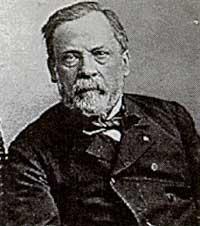Pasteur, Louis
(1822-1895)
Born at the Dole of Louis Pasteur Jua on 27 December 1822. As a young man he was not a good student. He showed interest in painting and some in mathematics, but in the rest (for example in chemistry) he drew bad notes.
As a student, he attended the lectures of Jean Baptiste Dumas and in the upbringing came the passion for chemistry. He studied at university and studied the influence of tartaric acid on polarized light.

In 1848 they revolted against King Louis Philipe and went out with the Pasteur revolutionaries. The revolutionaries won and followed the microscopic study of Pasteur Tartrate's crystal. He divided the tartrate crystals into two groups. The crystals of one group rotated the plane of polarization of light to one side and the other side to the other. Pasteur was only 26 when he laid the first foundations of polarimetry.
Pasteur gained fame especially in biology and medicine. In 1854, Dean of the Faculty of Sciences at the University of Lille, discovered that wine and beer were often drained in time. In 1856, an industrialist from Lille asked him to study the problem.
Pasteur took his microscope and quickly saw zero: the wine that was drained and the beer had long fermentable cells. There were two types of fermentable cells, those that produced alcohol (good) and those that produced lactic acid (bad).
Pasteur then noted the participation of living organisms in fermentation and the remedy not to pickle wine and beer. When wine and beer were made, little by little we had to heat up to 66 degrees Celsius: we had to graze to kill microscopic organisms.
Pasteur then took care of the creation of microscopic life. Some said that microorganisms were born out of nothing by themselves, but Pasteur was very religious and the author of life was God. Pasteur demonstrated the presence of spores in air dust and the proliferation of organisms.
In 1865 there was a serious problem in the sedera industry. The silkworms died from a disease and all sharpened their eyes towards Pasteur. Pasteur discovered a small parasite that polluted silkworms and marble leaves and ordered the immediate destruction of everything contaminated (silkworms and leaves). This saved the sedera industry.
But Pasteur had other ideas in mind. One thought there could be different ways to spread to the other: sneezing with droplets, droppings, tact, etc. This theory has had a great importance in medicine. Biologists then began to investigate bacteria.
In 1868 Prussia and France began the war. Concerned about the lack of hygiene in military hospitals, he was responsible for the doctors passing their appliances in boiling water. Despite not having a medical degree, he joined the French Academy of Medicine in view of his results.
He then took care of the disease known as the animal worm. Under a microscope he showed that the causes of the disease were hot and spore. The cattle affected by the disease had to be removed, but the cattle that suffered it were immunized. Half a century earlier, Edward Jenner managed to immunize the patient by partially inoculating a harmful disease and Pasteur prepared for it small doses of crust (low strength). In 1881 he introduced some sheep against the silk threads and others did not. Then he was able to verify that the vaccinated sheep did not hit diseases and that the others died.
With similar systems, he prepared vaccines against cholera and bird rabies in 1885 and in 1888 the Pasteur Institute was created to cure the sick of rabies.
The famous chemist Louis Pasteur died in Villeneuve-L'etans near Paris on 28 September 1895.
Buletina
Bidali zure helbide elektronikoa eta jaso asteroko buletina zure sarrera-ontzian











